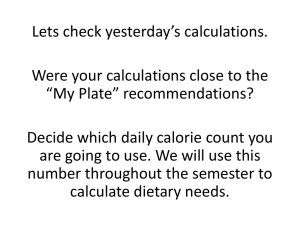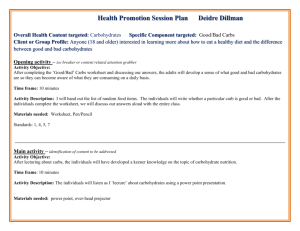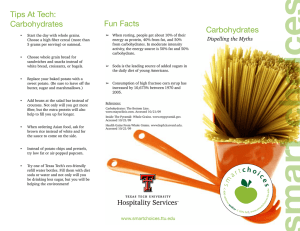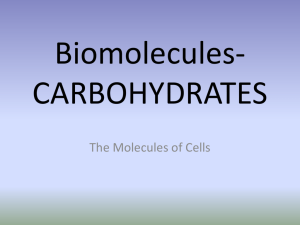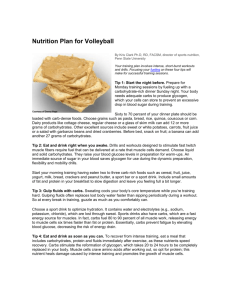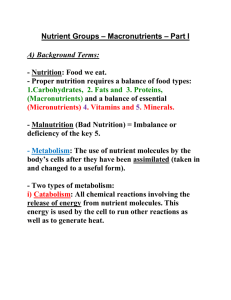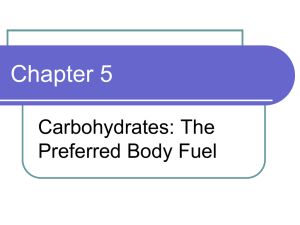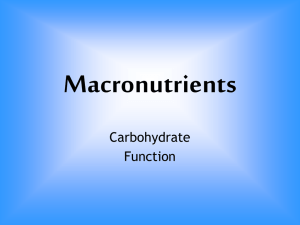Nutrition: Carbohydrates
advertisement
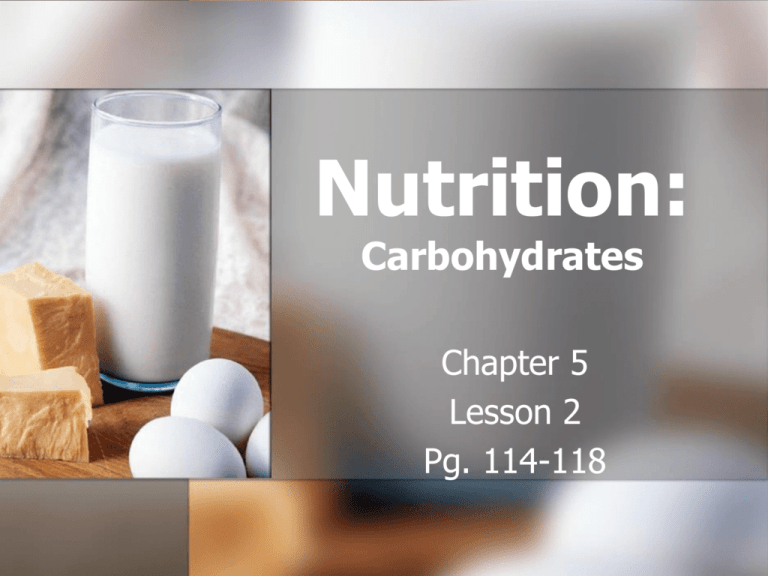
Nutrition: Carbohydrates Chapter 5 Lesson 2 Pg. 114-118 Nutrients Objective 1: Describe the functions of the simple and complex carbohydrates Objective 2: Describe the relationship between glucose and glycogen Objective 3: Identify some of the benefits of fiber What is a Carbohydrate? Carbohydrates (Carbs)- The starches and sugars present in foods. Made up of carbon, oxygen, and hydrogen Carbs provide, 4 calories per 1 gram Carbohydrates Your body uses the energy from the carbs everyday, for every task. 55-60% of your daily calories should come from complex carbs. Depending on their chemical make-up there are 2 types; Simple Complex Simple Carbohydrates What are simple carbohydrates? Also know as EMPTY CALORIES Sugars; fructose and lactose Found primarily in fruit and milk Most familiar; Sucrose Found naturally; plants Refined to make table sugar Sucrose is also added to manufactured foods http://abcnews.go.com/GMA/video/sugarbad-health-weight-alcohol-15496307 Simple Carbohydrates Videos Splenda http://www.youtube.com/watch?v=AhUyw2lcio http://video.foxnews.com/v/3914230/sour -news http://www.cbsnews.com/video/watch/?id =2720795n Sugar tasting lab Complex Carbohydrates What are complex carbohydrates? Starches Found primarily in; whole grains, nuts, seeds, legumes and tubers (root veggies) Did you know? Your body must break down complex carbs to simple carbs before it can use them for energy Complex Carbohydrates The Role Of Carbohydrates Your body converts all carbs to Glucose A simple sugar that’s the main source of energy for our bodies The glucose that is not used is stored in the liver and muscles as a starch-like substance called; glycogen. When your body needs more energy the glycogen is converted back to glucose. Excess carbs taken in and not used are converted to body fat Diabetes The pancreas makes the right amount of insulin to move glucose out from the blood to the cells. Type 1: The Pancreas does not make insulin because the body’s immune system has destroyed them Type 2: Over time, the body loses the ability to create enough insulin in response to meals. Fiber, What is it? What does it do? Is an indigestible complex carbohydrate that is found in tough, stringy parts of vegetables, fruits and whole grains. Fiber helps move waste through the digestive system and helps prevent against constipation. Why fiber reduces the risk of early death is unclear. Perhaps it's because fiber lowers levels of "bad" LDL cholesterol, improves blood glucose levels, reduces inflammation, and binds to potential cancer-causing agents, helping to flush them out of the body, says lead author Yikyung Park, a staff scientist at the National Cancer Institute. (article from us news.com) Fiber Did you know? That if you eat enough fiber throughout your life, it can help prevent against heart disease! It can also help control diabetes by reducing your blood glucose levels Eat between 20-35 grams of fiber a day! Sources Fruit Vegetables w/edible skins Whole grains Bran, cereal, oatmeal, brown rice How to get the Proper amount of Fiber… Start your day with a whole grain breakfast cereal; Oatmeal! Choose whole fruit instead of fruit juice Eat 5 servings of fruit and vegetables a day! Select high-fiber snacks Popcorn (no butter), raw veggies, nuts, apples, pears, peaches, plums (edible skin)

